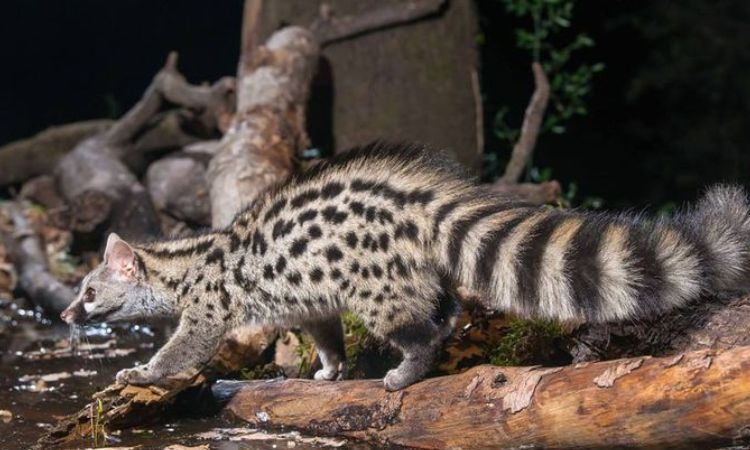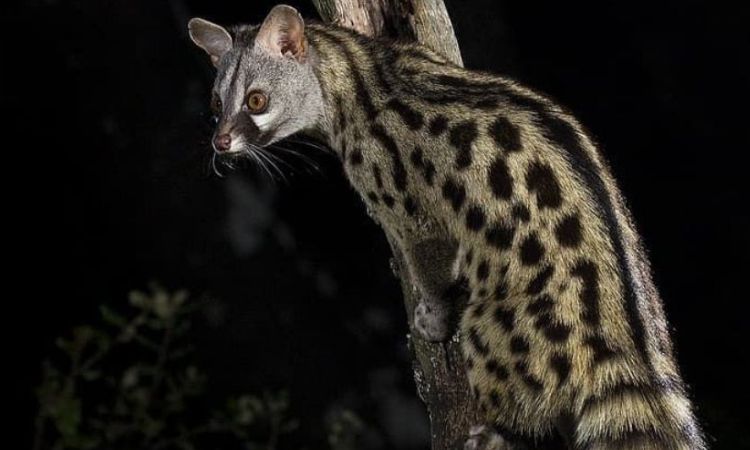African Civet Top Facts: Sound, Habitat, Musk, Diet, Size, & more
African Civet: Discover fascinating facts about the African civet, a nocturnal forest dweller. Learn about its habitat, diet, behavior, conservation status, and how to spot civets on a night safari in Uganda and Africa.
The African civet is one of Africa’s most elusive nocturnal creatures, often spotted only by the keenest wildlife enthusiasts on night safaris. This secretive mammal, with its striking black-and-white markings and musky scent, roams the shadows of Uganda’s lush forests and savannas.
As All Uganda Safaris, we specialize in revealing these hidden gems of African wildlife. Whether you’re tracking the African civet cat in Queen Elizabeth National Park or hoping for a glimpse during a night drive in Murchison Falls, this civet species in Africa captivates with its mystery and ecological importance.
In this guide, discover civet animal facts, from behavior to habitat, and learn why a Uganda safari is the ultimate way to encounter the African civet in the wild.
What Is an African Civet?
The African civet (Civettictis civetta) is a medium-sized, nocturnal mammal native to sub-Saharan Africa, belonging to the Viverridae family—distinct from true cats despite the common nickname “African civet cat.”
This civet species in Africa is the largest member of its family, blending traits of mongooses, genets, and small carnivores. In the wild, an African civet typically lives 10–12 years, though captivity can extend this to 20+ years with proper care.
At All Uganda Safaris, we often describe the African civet to guests as a “masked bandit of the night.” Its elusive nature makes sightings a highlight of our customized night game drives.
For an African civet definition, think solitary omnivore with a pivotal role in seed dispersal and pest control across Uganda’s diverse ecosystems.

Physical Characteristics of African Civet
The African civet appearance is unmistakable. Adults measure 68–89 cm in body length, with a 40–65 cm ringed tail, standing 35–40 cm at the shoulder. Weight ranges 7–20 kg, showcasing sexual dimorphism—males are noticeably larger than females.
Key civet markings include:
- A bold black-and-white striped coat for camouflage in dappled moonlight
- A raccoon-like black mask across the face
- Erectile dorsal crest that rises when threatened
- A long, bushy tail with 5–7 dark rings
- Sharp, retractable claws and robust teeth for climbing and tearing food
African civet anatomy supports agility: powerful limbs for tree-climbing and swimming, plus perianal musk glands producing the infamous civetone. On All Uganda Safaris night drives in Bwindi Impenetrable Forest, torchlight often reveals these civet characteristics as the animal freezes, crest raised, before vanishing into undergrowth.
African Civet Habitat and Distribution
Wondering where do civets live? The African civet habitat spans sub-Saharan Africa, from Senegal to Somalia and south to Namibia. In Uganda, prime civet distribution Africa zones include:
- Queen Elizabeth National Park (savannas and wetlands)
- Murchison Falls National Park (riverine forests)
- Bwindi Impenetrable Forest (dense montane jungle)
- Kibale National Park (tropical rainforest)
Civets thrive near permanent water, adapting to forests, woodlands, savannas, and even agricultural edges. Their versatility explains widespread presence yet localized rarity due to human encroachment.
We designs itineraries maximizing African civet habitat overlap with other nocturnal species. A night drive along the Kazinga Channel often yields civet tracks in soft mud, evidence of their nightly patrols.
Diet and Feeding Habits
The African civet diet is truly omnivorous, earning it the nickname “nature’s garbage collector.” What does a civet eat? A varied menu:
- Small mammals (rodents, hares)
- Birds and eggs
- Insects (beetles, termites)
- Reptiles and amphibians
- Fruits (wild figs, berries)
- Carrion and human food scraps
Civet feeding habits leverage strong jaws to crush bones and exoskeletons. Nocturnal foraging peaks 2–3 hours after sunset. Civets use scent-marking to claim food-rich territories, rubbing musk onto logs and grass.
During Uganda Safaris night excursions in Queen Elizabeth NP, adventurers witness civets raiding termite mounds or snatching fallen mangoes—demonstrating how the African civet controls insect populations and disperses seeds, enriching Uganda’s biodiversity.
Behavior and Lifestyle
African civet behavior centers on solitude and secrecy. Strictly nocturnal, civets emerge at dusk, retiring to dense cover by dawn. They are territorial, defending 2–6 km² with civetone musk—historically harvested for Chanel No. 5 perfume.
Agile climbers, civets ascend trees to escape predators or raid bird nests. Excellent swimmers, they cross rivers with ease. Playful yet cautious, they freeze at torchlight before bounding away.
Civet nocturnal habits include:
- Scent-marking every 100–200 m
- Grooming with raspy tongues
- Caching excess food
Expert park guides use red-filtered lights to minimize disturbance, allowing guests to observe civet territorial behavior without stress. In Murchison Falls, civets sometimes follow hyena kills, scavenging leftovers under starlit skies.

African Civet Sounds
African civet sounds pierce the night: deep growls warn intruders, high-pitched hisses signal alarm, and soft purr-like coughs indicate contentment. During mating, males emit rhythmic “ha-ha-ha” barks audible up to 500 m.
Civet communication relies heavily on scent, but civet vocalizations convey urgency. Pups whimper to locate mothers hidden in thickets.
On night game drives, the sudden growl of a startled civet electrifies the air—often the only clue before the animal melts into darkness. Recording these African civet sounds (with permission) creates lifelong safari memories.
African Civet Musk (Civetone)
The African civet produces a potent musk called civetone from perianal glands, historically prized in perfumery for its rich, animalic depth—once a key fixative in Chanel No. 5. This oily, yellowish secretion is scraped from wild or farmed civets and used sparingly in luxury fragrances.
In Uganda, traditional healers value civetone for medicinal rituals. However, cruel “civet farms” in Ethiopia and elsewhere confine animals in tiny cages for harvesting, prompting ethical bans.
Reproduction and Lifespan
African civet reproduction occurs year-round, peaking in rainy seasons when food abounds. Gestation lasts 60–80 days, yielding 1–4 (usually 2–3) pups per litter. Born blind and helpless in dense vegetation, civet babies open eyes at 10–12 days and follow the mother by 6 weeks.
Weaning completes by 3 months; independence by 6–12 months. Civet lifespan averages 10–12 years in the wild, limited by predation (leopards, pythons) and road accidents. Captive civets reach 25 years.
During wildlife safaris, occasionally spots mothers with half-grown pups in Kibale Forest—a rare, heartwarming sight underscoring the need to protect breeding habitats.
Threats and Conservation Status
The IUCN lists the African civet as Least Concern, yet local populations decline. Primary civet threats:
- Habitat loss (deforestation for agriculture)
- Snaring and hunting for bushmeat/fur
- Illegal civetone harvesting (cruel cage farming)
- Roadkill and domestic dog attacks
African civet conservation gains traction in Uganda’s national parks. Queen Elizabeth NP’s anti-poaching patrols and community education reduce snaring. we contributes 5% of profits to Uganda Wildlife Authority conservation funds, directly supporting civet habitat protection.
Tourism revenue incentivizes locals to preserve rather than persecute civets. Responsible night safaris minimize disturbance, ensuring future generations encounter this species.
African Civet in Culture and Ecotourism
In Ugandan folklore, civets symbolize cunning and mystery. Historically, Baganda healers used civetone in rituals. Today, African civet safari experiences drive ecotourism.
Top civet spotting Uganda locations:
- Queen Elizabeth NP – Ishasha sector night drives
- Murchison Falls NP – Nile delta floodplains
- Bwindi Impenetrable Forest – forest edge clearings
All Uganda Safaris pioneered red-light night drives, increasing civet sightings by 40% without stress. Guests depart with photos of glowing eyes and striped silhouettes—proof of Uganda’s nocturnal riches.
Fun Facts About African Civets
- Largest viverrid: bigger than genets, smaller than leopards
- Foul defense: sprays musk up to 1 m when cornered
- Super swimmers: cross Lake Albert tributaries effortlessly
- Seed superheroes: disperse over 30 plant species via scat
- Perfume legacy: 1 kg civetone once cost $500
- Tree toilets: defecate in specific latrines to mark territory
Are Civets Harmful to Humans?
African civets are not harmful to humans. Shy and nocturnal, they avoid contact, rarely bite unless cornered, and carry no major zoonotic diseases. Their musk smells foul but is harmless.
Is an African Civet Dangerous?
No, the African civet is not dangerous. Solitary and timid, it flees from humans. Bites are extremely rare and only in self-defense. It poses no threat on safaris.
Are African Civets Related to Raccoons?
No, African civets belong to Viverridae (mongooses, genets); raccoons are Procyonidae. Convergent evolution gives similar masks and ringed tails, but DNA shows no close relation.
Are African Civets Carnivores?
African civets are omnivores, not strict carnivores. They eat rodents, insects, birds, plus fruits, roots, and carrion—balancing meat and plant matter nightly.
Are African Civets Aggressive?
African civets are not aggressive. Shy, solitary, and nocturnal, they flee humans, only hissing or spraying musk if cornered. No unprovoked attacks recorded.
How to Keep Civets Away from Home?
Secure trash, remove pet food, seal entry points, and use motion-activated lights. Plant strong-scented herbs (mint, citronella). Avoid poison—use humane deterrents. Civets naturally avoid human areas.
Civet Diseases and Health Risks
African civets may carry rabies, leptospirosis, or parasites like ticks and fleas, but human transmission is rare due to their elusive nature. No major zoonotic outbreaks linked. Vaccinate pets; avoid handling wild civets.
Civet Role in Ecosystems
African civets control rodent and insect populations, disperse seeds via scat (aiding forest regeneration), and scavenge carrion, reducing disease spread. As mesopredators, they balance food webs in Uganda’s savannas and forests.
Civet Conservation Efforts
Uganda protects African civets under national wildlife laws in parks like Queen Elizabeth, Murchison Falls & Bwindi. UWA rangers run snare-removal patrols, community education cuts poaching for musk & bushmeat. All Uganda Safaris funds anti-poaching units & night-drive tourism that boosts local jobs while keeping civets wild.
Other African Mesopredators
- Black-backed jackal: Clever scavenger that controls rodents & carrion; thrives in savannas, often spotted on dusk drives in Queen Elizabeth NP.
- Caracal: Silent lynx-like hunter of birds & hares; red-light safaris reveal its tufted ears leaping in Murchison Falls grasslands.
- Serval: Tall-eared specialist pouncing on rats in wetlands; a nocturnal highlight near Kazinga Channel.
- Genet: Tree-climbing mini-leopard raiding nests; flashes spotted coats in Kibale Forest headlights.
Conclusion
The African civet may be elusive, but it plays a vital role in controlling insects and small animals, enriching forests, and seeding future generations of trees. From Bwindi’s misty mountains to Queen Elizabeth’s golden plains, this nocturnal marvel embodies Uganda’s wild heart.
Ready for your own encounter? Join All Uganda Safaris on a night safari in Uganda or Kenya to catch a glimpse of this secretive creature.
Our expert guides, red-light technology, and conservation commitment guarantee an ethical, unforgettable civet wildlife safari. Book today—spots fill fast under Africa’s starlit skies.
